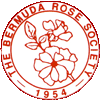Articles
1. Bermuda: A Museum of Roses
2. Smith’s Parish Rose: A Bermuda Mystery
3. WATERVILLE ROSE REPOSITORY GARDEN
THE BERMUDA ROSE SOCIETY FIRST ESTABLISHED A REPOSITORY GARDEN at Waterville, the home of the Bermuda National Trust, in 1988. It was created specifically for Old Garden Roses at the suggestion of Dr. Charles A. Walker, Jr., founder of the Heritage Rose Foundation. The waterside garden of the historic 18th century house is a beautiful location.
The formal Georgian garden was first designed to be in keeping with the house. It was an exciting time planning and propagating an official collection of Bermuda Mysteries, Old Garden Roses, Chinas, Teas, Noisettes, Polyanthas and others, which had proven their Bermudian status. Four rectangular beds were laid out on the site of the former croquet lawn, each with a border of small Boxwood hedges. Six established Bermuda Olivewoods, clipped for a formal appearance, stand at the corners. The steps and Cedar arbours were added in 1992.
A statue of the nymph Daphne being changed into a laurel tree to escape the advances of the god Apollo stands in the centre. It was a gift to the Trust from Mrs. Kitty Mount and is the work of American artist Barbara Lekber.
The first garden was not a complete success and so it was decided that the roses would do better in raised beds. A new classic garden was designed and built to celebrate the Millennium.
After careful planning by a team of helpers working with the Trust and under the leadership of Tuppy Cooper, the new beds were designed and laid out with recycled bricks. New soil was added and the roses, grown on their own roots from ‘slips’, were planted as a blend of colours, rather than classifications, with complementary companion plants. Over the years we have had visits and helpful advice from our many overseas friends in the United States, Europe, Australia and New Zealand. The gardens were officially opened on April 20th 2001 and dedicated to the preservation of Old Bermuda Roses.
Ann Brown took over the maintenance of the garden in 2002. Some roses have been replaced as they have declined and others have been added, including Modern Roses to see how well they would fare. Changes have been made, mainly to companion plants, on a trial and error basis.
During hurricane Fabian the adjacent 300-year old Tamarind tree was blown down on top of the garden. However, a new shoot has grown from the remaining roots and will once again shade the garden. The beds are fertilized during the winter months and there is also an irrigation system which feeds the roses for an hour each day when the soil is dry. During the summer, no fertilizer is added to the system when the roses are resting. The roses are sprayed regularly, using a highly successful solution of castile soap and water.
The Bermuda Mystery climbers growing on trellises planted around the tank of the house did not do well and most of them died. It was decided not to replace them as the soil was possibly salty, being so close to the harbour and tidal water.
Sadly, Ann Brown died in 2009. Memorial contributions in Ann’s name were dedicated to assisting with the production of this book. Sally Madden, who had been working closely with Ann, stepped in to continue the maintenance of the garden. Pruning, kept to a minimum, is limited to removing dead wood and shaping the bushes. We still do a major soil improvement and fertilization once a year and add a layer of fresh mulch. In 2010 hurricane Igor damaged many of the roses which have since been replaced.
In October 2011 Lisa Marshall became our team leader. Our volunteers work in their own time in twos or threes on different days. New volunteers are always encouraged and welcomed. There is a record book in which to write comments (notes), which keeps us all aware of what others are doing. The annual schedule of maintenance will remain the same.
Groups of artists and school children are sometimes seen in the garden. Bermudians and visitors walk through and use the garden as a peaceful resting place and they can sit on benches that were dedicated to past presidents of The Bermuda Rose Society. The Society tries to have one meeting, usually in April, in the Waterville Garden when all members can take the opportunity to visit and, we hope, gain pleasure in the Society’s Repository Garden.
4. Bermuda’s Anna Olivier
BERMUDA’S ANNA OLIVIER
One of our favourites for cutting, this has been moved back from the ‘Tea’ classification (though it is obviously a Tea) to Mysteries, because its colouration is at variance with the descriptions of ‘Anna Olivier’ (Ducher 1872) grown elsewhere.. This is a vigorous bush with good form, growing to a height of 5-6 ft. (1.5-1.8 m). The foliage is light to medium green. Buds are pointed, showing faint pink colour and open to buff or pale creamy-yellow high-centred blooms sometimes tinged with pink. Turning a deeper yellow with maturity, the blooms can be as much as 3 ½ in.(9 cm) across. When fully open, the centres are quite muddled. Both peduncle and receptacle are finely bristled. Balls in wet weather and can be prone to blackspot. Blooms all year, prolifically. When the Australian ladies and authors of the book, Tea Roses, Old Roses for Warm Gardens, visited Bermuda in 2010, they were most positive that our Anna Olivier is the rose ‘Etoile de Lyon’. Gregg Lowery of Vintage Gardens agrees with this identification. They also said that in Australia it has been sold under the name ‘Lady Roberts’.


